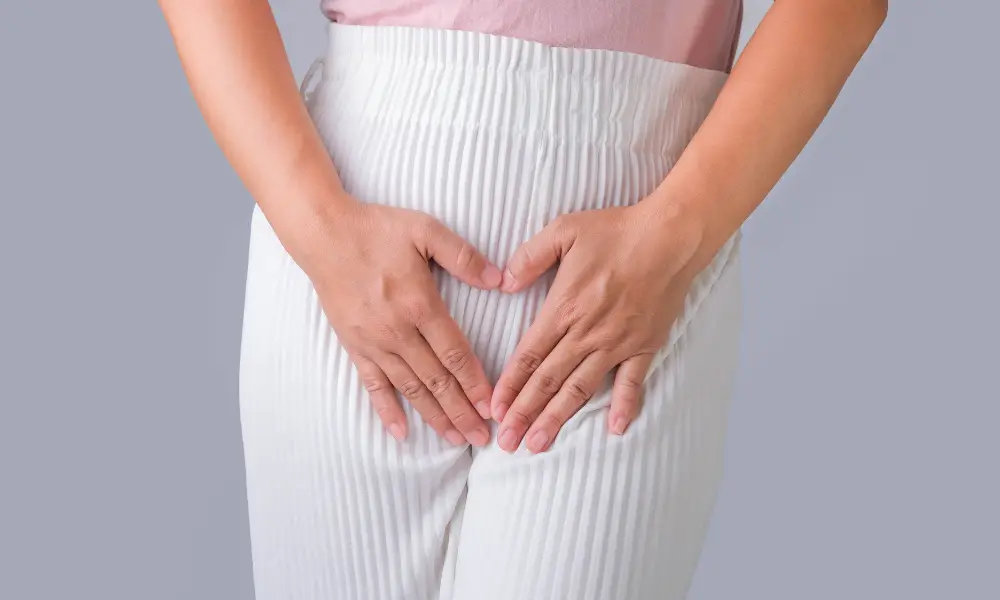Postmenopausal dyspareunia, often an unspoken concern, refers to pain during sexual intercourse experienced by women after menopause. The hormonal changes that accompany this phase of life can lead to various challenges, impacting both physical and emotional well-being. In this comprehensive guide, we will explore the causes of postmenopausal dyspareunia, traditional tips to choose the right treatment and lifestyle changes that can make a significant difference.
Contents
Causes Of Postmenopausal Dyspareunia 
Postmenopausal dyspareunia, or pain during sexual intercourse after menopause, can be attributed to various factors related to hormonal changes, vaginal health, and other physiological and psychological factors. Here are the causes in detail:
- Hormonal Changes
- Estrogen Decline: Significant decrease in estrogen levels during menopause.
- Effects: Thinning, dryness, and reduced elasticity of vaginal tissues.
- Vaginal Dryness and Atrophy
- Lack of Lubrication: Reduced estrogen leads to inadequate vaginal lubrication.
- Vaginal Atrophy: Thinning of vaginal walls due to estrogen depletion.
- Decreased Blood Flow
- Vasoconstriction: Estrogen decline results in reduced blood flow to the genital area.
- Pelvic Floor Changes
- Muscle Atrophy: Decreased estrogen contributes to pelvic floor muscle atrophy.
- Inflammation and Infection
- Thinning Tissues: Vulnerability to irritation, inflammation, and infection.
- Psychological Factors
- Mood and Stress: Emotional factors like stress, anxiety, and depression impact sexual desire.
- Medical Conditions
- Vulvodynia: Chronic vulvar pain, burning, or discomfort.
- Genitourinary Syndrome of Menopause (GSM): Symptoms related to estrogen deficiency.
- Medications
- Hormone Replacement Therapy (HRT): Poorly managed HRT or certain medications may contribute.
- Scar Tissue
- Previous Surgeries or Trauma: Scarring from surgeries or pelvic trauma.
- Lack of Sexual Activity
- Reduced Lubrication: Lack of sexual activity may lead to decreased blood flow and lubrication.
- Lifestyle Factors
- Smoking: Associated with an increased risk of postmenopausal symptoms, including dyspareunia.
Women experiencing postmenopausal dyspareunia should seek medical advice for a thorough evaluation and tailored treatment plan.
Medical Evaluation Of Postmenopausal Dyspareunia
Postmenopausal dyspareunia refers to pain during sexual intercourse that occurs after menopause. It can be caused by various factors related to changes in hormonal levels and the aging process. The medical evaluation of postmenopausal dyspareunia typically involves a thorough assessment of both physical and psychological factors. Here’s a general outline of the evaluation process:
- Medical History
- The healthcare provider will start by taking a detailed medical history. This includes asking about the onset, duration, and nature of the pain.
- Information about any pre-existing medical conditions, medications, surgical history, and gynecological history will be collected.
- Menopausal Status
Confirmation of menopausal status is essential. Menopause is defined as the absence of menstrual periods for at least 12 consecutive months. This may involve assessing the woman’s age, symptoms, and hormonal levels. - Hormonal Evaluation
Hormonal imbalances, especially a decrease in estrogen levels, can contribute to postmenopausal dyspareunia. Blood tests may be performed to assess hormone levels, including estrogen, progesterone, and testosterone. - Pelvic Examination
A pelvic examination is conducted to assess the health of the pelvic organs. The healthcare provider will check for any signs of atrophy, dryness, or inflammation in the vaginal tissues. - Vaginal pH Testing
An elevated vaginal pH may indicate a lack of estrogen. A pH test can be done using pH strips to measure acidity levels in the vagina. - Cytology and Cultures
Vaginal cytology may be performed to examine the cells in the vaginal lining. Additionally, cultures may be taken to rule out infections that could be contributing to the pain. - Imaging Studies
In some cases, imaging studies such as pelvic ultrasound may be recommended to visualize the pelvic organs and identify any structural abnormalities. - Psychosocial Assessment
Psychological factors can play a role in dyspareunia. A discussion about sexual health, relationship issues, and emotional well-being may be included in the evaluation.
Traditional Treatment Approaches For Postmenopausal Dyspareunia 
Traditional treatment approaches for postmenopausal dyspareunia aim to address the underlying causes of pain during sexual intercourse that occurs after menopause. These approaches often focus on relieving symptoms related to hormonal changes and vaginal health. Here are common traditional treatment options:
- Hormone Replacement Therapy (HRT)
- Description: Uses estrogen and sometimes progesterone to supplement declining hormone levels.
- Benefits: Restores vaginal lubrication, and increases the thickness of vaginal tissues.
- Considerations: Discuss risks and benefits with a healthcare provider.
- Local Estrogen Therapy
- Description: Involves creams, vaginal tablets, or rings applied directly to the vaginal area.
- Benefits: Rejuvenates vaginal tissues, improves elasticity.
- Considerations: Preferred for localized symptoms; minimal systemic absorption.
- Vaginal Moisturizers and Lubricants
- Description: Over-the-counter products for immediate relief of dryness during sexual activity.
- Benefits: Enhances lubrication, readily available.
- Considerations: Regular use, particularly before intercourse, can manage symptoms.
- Pelvic Floor Physical Therapy
- Description: Involves exercises to strengthen and improve pelvic floor muscles.
- Benefits: Addresses muscle atrophy, and improves pelvic health.
- Considerations: Beneficial for pelvic floor dysfunction contributing to dyspareunia.
- Counseling and Education
- Description: Provides emotional support, and education on coping strategies.
- Benefits: Addresses psychological factors contributing to pain.
- Considerations: Helpful when emotional barriers impact sexual comfort.
- Topical Anesthetics
- Description: Includes products like lidocaine to numb vaginal tissues temporarily.
- Benefits: Provides short-term relief, especially before sexual activity.
- Considerations: Regular use may be necessary; long-term use should be discussed with a healthcare provider.
- Lifestyle Modifications
- Description: Involves maintaining a healthy diet, hydration, and avoiding irritants.
- Benefits: Supports overall well-being, and may contribute to improved vaginal health.
- Considerations: Complementary to other treatment approaches.
It’s essential for women experiencing postmenopausal dyspareunia to consult with a healthcare provider for a personalized treatment plan, considering specific symptoms, overall health, and individual preferences. Regular follow-ups help assess the effectiveness of interventions and make adjustments as needed.
Lifestyle Changes For Alleviating Symptoms Of Postmenopausal Dyspareunia
Lifestyle changes can complement traditional treatment approaches and help alleviate symptoms of postmenopausal dyspareunia. Here are lifestyle modifications that may be beneficial:
- Regular Sexual Activity
Engage in regular sexual activity to promote blood flow to the genital area and maintain vaginal elasticity. - Extended Foreplay
Prioritize extended foreplay to enhance arousal and natural lubrication before intercourse. - Use of Lubricants
Apply water-based or silicone-based lubricants before sexual activity to reduce friction and discomfort. - Avoid Irritants
Avoid using harsh soaps, perfumes, or scented products in the genital area, as they can irritate sensitive tissues. - Stay Hydrated
Drink plenty of water to maintain hydration levels, which can help improve overall vaginal health and lubrication. - Healthy Diet
Consume a balanced diet rich in fruits, vegetables, lean proteins, and whole grains to support overall well-being. - Regular Exercise
Engage in regular physical activity, such as walking, swimming, or yoga, to improve circulation and promote pelvic floor muscle strength. - Pelvic Floor Exercises
Practice Kegel exercises to strengthen pelvic floor muscles, which can enhance vaginal tone and support. - Stress Management
Practice stress-reduction techniques such as deep breathing, meditation, or yoga to alleviate tension and promote relaxation. - Smoking Cessation
If applicable, quit smoking to improve vascular health and reduce the risk of vaginal dryness and discomfort. - Communication with Partner
Communicate openly with your partner about your symptoms and needs during sexual activity to ensure a supportive and understanding environment. - Comfortable Positions
Experiment with different sexual positions to find those that minimize discomfort and maximize pleasure. - Regular Pelvic Exams
Schedule regular pelvic exams with your healthcare provider to monitor vaginal health and address any underlying issues promptly. - Maintain Overall Health
Attend regular check-ups and screenings to monitor overall health and address any underlying medical conditions that may contribute to dyspareunia.
Tips For Choosing The Right Treatment 
Choosing the right treatment for postmenopausal dyspareunia involves a personalized approach based on the individual’s specific symptoms, health history, and preferences. Here are some tips to help guide the decision-making process:
- Consultation with Healthcare Provider
Seek the guidance of a healthcare professional, preferably a gynecologist or a specialist in menopausal health. A thorough evaluation by a qualified expert will help identify the underlying causes and tailor the treatment plan to your needs. - Understand the Underlying Causes
Different factors can contribute to postmenopausal dyspareunia, including hormonal changes, vaginal atrophy, infections, or psychological factors. Understanding the root cause will guide the selection of appropriate treatments. - Non-Hormonal Options
For women who cannot or prefer not to use hormonal therapy, non-hormonal options are available. These may include vaginal moisturizers and lubricants to alleviate dryness and discomfort during intercourse. - Vaginal Dilators
Vaginal dilators may be recommended to gradually stretch and condition the vaginal tissues. This can be particularly helpful for women experiencing tightness or discomfort. - Counseling and Psychological Support
For cases where psychological factors contribute to dyspareunia, counseling or sex therapy may be beneficial. Addressing emotional concerns and improving communication with a partner can positively impact sexual well-being. - Regular Follow-Up
Stay in regular contact with your healthcare provider for follow-up assessments. Adjustments to the treatment plan may be necessary based on your response and any changes in symptoms. - Consider Complementary Therapies
Some women find relief through complementary therapies such as acupuncture, mindfulness, or dietary supplements. Discuss these options with your healthcare provider to ensure they complement the overall treatment plan. - Review Potential Risks and Benefits
Before starting any treatment, discuss the potential risks and benefits like with hormone therapy with your healthcare provider. - Patient Education
Educate yourself about the available treatment options, their mechanisms, and potential side effects.
Conclusion
In conclusion, navigating the path to comfort and confidence in postmenopausal dyspareunia treatment involves a multifaceted approach. By understanding the causes, exploring traditional and emerging treatments, and embracing lifestyle changes, women can reclaim their sexual well-being. It’s crucial to seek professional guidance, stay informed, and foster open communication with healthcare providers to embark on a personalized journey to lasting relief.
If you are facing menopause related issues, menopause treatment at HerMantra can help. Book your free trial online menopause treatment session now.





